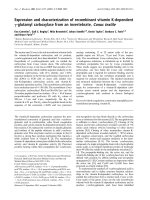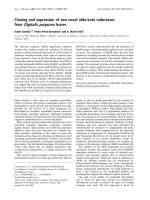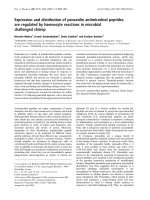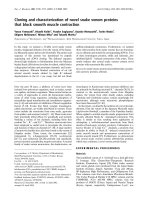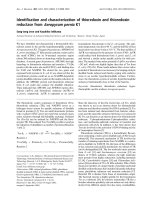Báo cáo y học: "Prevalence and correlates of being bullied among in-school adolescents in Beijing: results from the 2003 Beijing Global" docx
Bạn đang xem bản rút gọn của tài liệu. Xem và tải ngay bản đầy đủ của tài liệu tại đây (259.24 KB, 6 trang )
BioMed Central
Page 1 of 6
(page number not for citation purposes)
Annals of General Psychiatry
Open Access
Primary research
Prevalence and correlates of being bullied among in-school
adolescents in Beijing: results from the 2003 Beijing Global
School-Based Health Survey
Alice Hazemba
1
, Seter Siziya*
1
, Adamson S Muula
2
and
Emmanuel Rudatsikira
3
Address:
1
Department of Community Medicine, University of Zambia Medical School, Lusaka, Zambia,
2
Department of Community Health,
University of Malawi, Blantyre, Malawi and
3
Departments of Global Health, Biostatistics and Epidemiology, School of Public Health, Loma Linda
University, Loma Linda, CA, USA
Email: Alice Hazemba - ; Seter Siziya* - ; Adamson S Muula - ;
Emmanuel Rudatsikira -
* Corresponding author
Abstract
Background: Bullying has public health importance. It has been reported that both the victims and
perpetrators of bullying are more likely to have suicidal ideation and other suicidal behaviours.
Moreover, bullying can be a precursor for school violence and can contribute to poor academic
performance. The purpose of the study was to raise awareness on the subject in China. We,
therefore conducted an analysis of secondary data to determine the prevalence and correlates of
having been bullied among in-school adolescents.
Methods: The data was taken from the Beijing Global School-Based Health Survey conducted in
2003. A weighted analysis to reduce bias due to differing patterns of non-response was conducted
using statistical software (SPSS version 14.0). We conducted a backward logistic regression analysis
to determine independent predictors for being bullied.
Results: Out of a total of 2,348 in-school adolescents who participated in the survey, 20% (23%
males, and 17% females) reported having been bullied. Risk factors for having been bullied were
loneliness (adjusted odds ratio (AOR) = 1.44; 95% confidence interval (CI) 1.42–1.45), being
worried (AOR = 1.30; 95% CI 1.29–1.32), being sad or having feelings of hopelessness (AOR = 1.21;
95% CI 1.19–1.22), smoking cigarettes (AOR = 1.09; 95% CI 1.08–1.11), drinking alcohol (AOR =
1.31; 95% CI 1.29–1.32), and being truant (AOR = 1.24; 95% CI 1.22–1.27). Meanwhile protective
factors were having close friends (AOR = 0.84; 95% CI 0.83–0.86), receiving parental supervision
(AOR = 0.80; 95% CI 0.80–0.81), and ever been drunk (AOR = 0.86; 95% CI 0.84–0.87).
Conclusion: We believe the results of this study will raise awareness among school health
practitioners and administrators, paediatric psychiatrists and psychologists on the prevalence and
correlates of bullying among adolescents in Beijing, China.
Published: 2 April 2008
Annals of General Psychiatry 2008, 7:6 doi:10.1186/1744-859X-7-6
Received: 20 August 2007
Accepted: 2 April 2008
This article is available from: />© 2008 Hazemba et al; licensee BioMed Central Ltd.
This is an Open Access article distributed under the terms of the Creative Commons Attribution License ( />),
which permits unrestricted use, distribution, and reproduction in any medium, provided the original work is properly cited.
Annals of General Psychiatry 2008, 7:6 />Page 2 of 6
(page number not for citation purposes)
Background
Bullying is a major source of victimisation among youth
[1-6]. Although there has been growing interest in the
topic in the last 20 years [1-8], studies that have been
reported have mainly come from Europe and the United
States. There are also some reports from Hong Kong, India
and Korea [9-12].
Wong has reported that if left uncurbed, bullying can be a
precursor of school violence and delinquency [13]. Kim et
al. [9] reported that both the victims and perpetrators of
bullying were more likely to report suicidal ideation and
other suicidal behaviours than those not associated with
bullying. In a US study reported by Nansel et al. [14] in
which 15,686 students in grades 6 to 10 were studied, bul-
lying others and being bullied were consistently associ-
ated with self-report of weapon carrying, weapon carrying
in school, physical fighting, and being injured in a physi-
cal fight. Harel previously reported that bullying of girls in
Kenya was contributing to low academic achievement
[15]. Therefore, bullying has important public health sig-
nificance. While the majority of reports on bullying are
from studies conducted among youth and in-school chil-
dren, it is also important to recognise that bullying may
also occur among adults, and also in out-of-school set-
tings. Bullying may occur at work [16,17] or within prison
settings [18,19]. For the current study however, our inter-
est is in adolescents in in-school settings.
Despite the fact that there is growing interest on adoles-
cents' in-school bullying, there are limited data from the
emerging economy nations such as China. In order to
raise awareness on the subject in China, we therefore con-
ducted a secondary analysis of the Beijing Global School-
Based Health Survey (2003) to investigate the prevalence
and correlates of having been bullied within the last 30
days among in-school adolescents.
Methods
Study design
This study involved secondary analysis of existing data
available from the Beijing Global School-Based Health
Survey (GSHS) conducted in 2003. The GSHS was devel-
oped by the World Health Organization (WHO) in col-
laboration with The United Nations Children's Fund
(UNICEF), The United Nations Educational, Scientific
and Cultural Organization (UNESCO) and The United
Nations Joint Programme on HIV/AIDS (UNAIDS), with
technical assistance from the Centers for Diseases Control
and Prevention (CDC), Atlanta, GA, USA. The GSHS aims
to provide data on health and social behaviours among
in-school adolescents. In Beijing, students from grades 1
to 4 of junior middle school were recruited.
Sampling
The 2003 Beijing GSHS used a two-stage probability sam-
pling technique. In the first stage of sampling, the sam-
pling frame consisted of all junior middle schools.
Schools were selected with probability proportional to
school enrolment size. In the second step, a random sam-
ple of classes in the selected schools was obtained. All stu-
dents in the selected classes were eligible to participate in
the survey. All the 25 selected schools participated in the
survey. Altogether, 2,348 students were enrolled into the
survey with a response rate of 99%.
Ethical issues
The privacy of students was protected by allowing for
anonymous and voluntary participation [20]. The ques-
tionnaire was self-completed by students within one class
period.
Data analysis
Data analysis was performed using SPSS version 14.0 soft-
ware. A weighting factor was used in the analysis to reflect
the likelihood of sampling each student and to reduce
bias by compensating for differing patterns of non
response. The weight used for estimation is given by the
following formula:
W = W1 * W2 * f1 * f2 *f3 *f4
Where W1 = the inverse of the probability of selecting the
school, W2 = the inverse of the probability of selecting the
classroom within the school, fl = a school-level non
response adjustment factor calculated by school size cate-
gory (small, medium, large), f2 = a class-level non
response adjustment factor calculated for each school, f3
= a student-level non response adjustment factor calcu-
lated by class, and f4 = a post stratification adjustment fac-
tor calculated by grade.
We used the following questions for the outcome of inter-
est and some of the explanatory variables: "During the
past 30 days, on how many days were you bullied?", with
the responses 0 days, 1 or 2 days, 3 to 5 days, 6 to 9 days,
10 to 19 days, 20 to 29 days, all 30 days. As we were inter-
ested in any history of having been bullied, we recoded
the variable to a binary variable with responses of zero for
0 days and one for any number of days bullied. A follow
up question indicated how "being bullied" was defined in
the survey: "During the past 30 days, how were you bul-
lied most often?". The possible responses were: "I was not
bullied during the past 30 days", "I was hit, kicked,
pushed, shoved around, or locked indoors", "I was made
fun of because of my race or colour", "I was made fun of
because of my religion", "I was made fun of with sexual
jokes, comments, or gestures", "I was left out of activities
on purpose or completely ignored", "I was made fun of
Annals of General Psychiatry 2008, 7:6 />Page 3 of 6
(page number not for citation purposes)
because of how my body or face looks", and "I was bullied
in some other way". The other questions that we used in
the analysis were: "During the past 12 months, how often
have you felt lonely?", "During the past 12 months, how
often have you been so worried about something that you
could not sleep at night?", "During the past 12 months,
did you ever feel so sad or hopeless almost every day for
two weeks or more in a row that you stopped doing your
usual activities?", "How many close friends do you
have?", "During your life, how many times did you drink
so much alcohol that you were really drunk?". We also
used data on age and gender (sex). Tian et al. [20] reported
that the data arising from the above variables are of
acceptable quality.
We obtained frequencies as estimates of prevalence rates.
We conducted a backward logistic regression analysis to
estimate the associations between relevant predictor vari-
ables and the outcome. The predictor variables were iden-
tified from the literature as possible factors that may be
associated with having been a victim of bullying [11,21-
27]. We report unadjusted odds ratios for selected predic-
tor variables while considering having been bullied in the
past month as a dependent variable. We also report results
from a multivariate analysis (adjusted odds ratios) to
determine independent predictors for the outcome.
Results
Description of the study sample
A total of 2,348 in-school adolescents participated in the
Beijing Global School-Based Survey of 2003. For those
study participants whose data were available, 32.6% were
of age 14 years, 49.5% were females, and 20% reported
having been bullied in the past month (23% among boys
versus 17% among girls). Further description of the study
sample is given in Table 1.
Factors associated with being a victim of bullying
Bivariate and multivariate analyses produced similar
results (Table 2), except for ages <13 and 13 years, and
ever been drunk. While odds ratios for <13 and 13 years
indicated that these groups were protective in bivariate
analysis, these ages were risk factors in multivariate analy-
sis. Ever been drunk was a risk factor in bivariate analysis
but was a protective factor in multivariate analysis. We
highlight the results obtained in the multivariate analysis.
Compared to older adolescents of age 16 years or more,
younger adolescents (<15 years) were more likely to be
bullied. However, adolescents of age 15 years were less
likely to be bullied. Male adolescents were 21% (adjusted
odds ratio (AOR) = 1.21; 95% confidence interval (CI)
1.20–1.22) more likely to be bullied compared to female
adolescents.
The other risk factors that were identified in the analysis
were loneliness (AOR = 1.44; 95% CI 1.42–1.45), being
worried (AOR = 1.30; 95% CI 1.29–1.32), and being sad
or having feelings of hopelessness (AOR = 1.21; 95% CI
1.19–1.22). Adolescents who had close friends were 16%
(AOR = 0.84; 95% CI 0.83–0.86) less likely to be bullied
compared to adolescents who had no close friends. Ado-
lescents who reported having received parental supervi-
sion were 20% (AOR = 0.80; 95% CI 0.80–0.81) less likely
to be bullied.
Adolescents who smoked cigarettes were 9% (AOR = 1.09;
95% CI 1.08–1.11) more likely to be bullied compared to
non-smokers. While adolescents who drank alcohol were
31% (AOR = 1.31; 95% CI 1.29–1.32) more likely to be
bullied compared to adolescents who did not take alco-
hol, adolescents who ever had been drunk were 14%
(AOR = 0.86; 95% CI 0.84–0.87) less likely to be bullied.
Finally, adolescents who reported having been truant
were 24% (AOR = 1.24; 95% CI 1.22–1.27) more likely to
be bullied compared to adolescents who never missed
classes.
Discussion
Our study reports an overall prevalence of being bullied
over the past 30 days to the survey among Beijing students
of 20%. Males were more likely to have reported being
victims of bullying than females (23% versus 17%, respec-
tively). In South Africa, Liang et al. [27] reported a 12
months prevalence of being a victim of bullying of 19.3%
among adolescents. Kepenekci and Çınkır [25] reported
that in a sample of 692 Turkish high school students, all
students reported having been bullied in the current aca-
demic year. In this Turkish study, 35.0% reported that
they had been bullied verbally, 35.5% had been bullied
physically, 28.3% had been bullied emotionally, and
15.6% had been bullied sexually, at least once during the
academic year. That having been a victim of bullying was
universal appears surprising. However, this may have
resulted from how bullying was defined. Bullying com-
prises different forms including verbal (such as being
made fun of, and teasing) and physical forms (such as hit-
ting, kicking, pushing, and being locked indoors) [28].
Our study found that males were more likely to have been
victims of bullying compared to females. Munni and
Mahli [29] reported that females were more likely to be
victims of bullying. In the sample of Turkish high school
students, boys were more likely to have suffered physical
bullying including kicking/slapping, assault with a knife,
and rude physical jokes than girls. Kshirsagar et al. how-
ever reported that the prevalence of bullying was the same
among boys and girls in co-education schools in India
[11].
Annals of General Psychiatry 2008, 7:6 />Page 4 of 6
(page number not for citation purposes)
We found that adolescents who reported having been bul-
lied were also more likely to have smoked, used alcohol,
ever gotten drunk, felt hopeless, been worried, felt sad,
and been truant. These factors have been reported to be
associated with bullying victimization. However due to
the cross sectional nature of the study, it is not possible to
determine whether these factors are the consequences of
having been bullied or are in the causal pathway. Bond et
al. [30] reported in a prospective study that girls who were
once victims of bullying were more likely to have depres-
sion. In another prospective study, Gladstone et al. [31]
reported that victims of bullying suffered anxiety later in
life.
Limitations of the study
Our study has a number of limitations. Firstly, data were
collected through self-reports. As in all such studies, both
inadvertent and deliberate misreporting is a concern.
However, the collection of data in this study was anony-
mous. This may have discouraged deliberate misreport-
ing. This study asked participants whether they had been
bullied. The information that was given depended on
each adolescent's understanding of bullying. In a setting
where the subject matter has not been adequately
addressed in common language usage, the problem of
having diverse interpretations amongst study participants
multiplies. Although the study was conducted in Chinese
so as to minimise misunderstanding of terms, the transla-
Table 1: Sample description of study participants in the Beijing 2003 Global School-Based Survey
Factor Total, n (%)* Male, n (%)* Female, n (%)*
Age
≤12 274 (12.6) 125 (11.8) 142 (12.8)
13 588 (25.5) 256 (23.0) 332 (28.3)
14 788 (32.6) 373 (32.1) 415 (33.4)
15 560 (23.5) 293 (25.7) 267 (21.4)
16+ 136 (5.8) 84 (7.5) 52 (4.2)
Sex
Male 1131 (50.5) - -
Female 1210 (49.5) - -
Loneliness
Yes 1354 (57.2) 607 (53.6) 746 (61.2)
No 990 (42.8) 521 (46.4) 463 (38.8)
Worried
Yes 1169 (49.3) 514 (45.4) 652 (53.4)
No 1174 (50.7) 613 (54.6) 557 (46.6)
Sad/hopeless
Yes 442 (19.0) 222 (19.9) 217 (18.0)
No 1888 (81.0) 895 (80.1) 989 (82.0)
Had close friend
Yes 2163 (92.4) 1044 (92.7) 1114 (92.2)
No 177 (7.6) 81 (7.3) 94 (7.8)
Smoked cigarettes
Yes 205 (9.2) 177 (16.2) 27 (2.1)
No 2101 (90.8) 917 (83.8) 1178 (97.9)
Drank alcohol
Yes 278 (12.9) 187 (18.1) 91 (7.8)
No 1917 (87.1) 854 (81.9) 1056 (92.2)
Ever been drunk
Yes 184 (8.0) 132 (11.8) 52 (4.2)
No 2139 (92.0) 988 (88.2) 1144 (95.8)
Missed classes
Yes 112 (4.9) 70 (6.3) 41 (3.5)
No 2227 (95.1) 1055 (93.7) 1166 (96.5)
Parental supervision
Always 585 (25.3) 265 (23.7) 318 (26.8)
Not always 1752 (74.7) 858 (76.3) 889 (73.2)
Bullied
Yes 439 (20.0) 244 (23.0) 194 (17.0)
No 1777 (80.0) 816 (77.0) 955 (83.0)
*n = unweighted frequency; weighted percentages were used.
Annals of General Psychiatry 2008, 7:6 />Page 5 of 6
(page number not for citation purposes)
tion of the GSHS questionnaire may have altered the
meaning or interpretation of questions or responses. This
would make it difficult to compare the current findings
with findings from other settings. However, Tian et al. [20]
reported that the data used in the current study are of
acceptable quality.
Conclusion
We have for the first time reported the prevalence of bul-
lying among in-school adolescents in Beijing, China. We
believe this report will raise awareness on the problem of
bullying behaviours among students in this setting.
Efforts to prevent and control bullying behaviours need to
consider the factors that are associated with the behav-
iour.
Competing interests
The author(s) declare that they have no competing inter-
ests.
Authors' contributions
AH conducted data analysis, participated in the interpre-
tation of the results, and drafting of the manuscript. SS
conducted a re-analysis of data, participated in the inter-
pretation of results, and drafting of the manuscript. ASM
participated in the interpretation of the results, and draft-
ing of the manuscript. ER participated in the interpreta-
tion of the results, and drafting of the manuscript. All
authors read and approved the final manuscript.
Acknowledgements
We are grateful to the World Health Organisation (Geneva) for making the
data on the Beijing Global School-Based Survey available for our analysis.
Table 2: Factors associated with being bullied
Factor Crude odds ratio (95% CI) Adjusted odds ratio (95% CI)
Age
≤12 0.98 (0.96–1.00) 1.29 (1.26–1.32)
13 0.92 (0.90–0.93) 1.04 (1.02–1.05)
14 1.23 (1.21–1.24) 1.20 (1.18–1.22)
15 0.95 (0.93–0.96) 0.79 (0.77–0.80)
16+ 1 1
Sex
Male 1.21 (1.20–1.22) 1.21 (1.20–1.22)
Female 1 1
Loneliness
Yes 1.58 (1.56–1.59) 1.44 (1.42–1.45)
No 1 1
Worried
Yes 1.43 (1.42–1.45) 1.30 (1.29–1.32)
No 1 1
Sad/hopelessness
Yes 1.43 (1.41–1.44) 1.21 (1.19–1.22)
No 1 1
Had close friends
Yes 0.75 (0.74–0.76) 0.84 (0.83–0.86)
No 1 1
Smoked cigarettes
Yes 1.28 (1.26–1.29) 1.09 (1.08–1.11)
No 1 1
Drank alcohol
Yes 1.45 (1.43–1.46) 1.31 (1.29–1.32)
No 1 1
Ever been drunk
Yes 1.29 (1.28–1.31) 0.86 (0.84–0.87)
No 1 1
Missed classes
Yes 1.49 (1.47–1.52) 1.24 (1.22–1.27)
No 1 1
Parental supervision
Yes 0.70 (0.70–0.71) 0.80 (0.80–0.81)
No 1 1
Publish with BioMed Central and every
scientist can read your work free of charge
"BioMed Central will be the most significant development for
disseminating the results of biomedical research in our lifetime."
Sir Paul Nurse, Cancer Research UK
Your research papers will be:
available free of charge to the entire biomedical community
peer reviewed and published immediately upon acceptance
cited in PubMed and archived on PubMed Central
yours — you keep the copyright
Submit your manuscript here:
/>BioMedcentral
Annals of General Psychiatry 2008, 7:6 />Page 6 of 6
(page number not for citation purposes)
References
1. Fitzpatrick KM: Exposure to violence and presence of depres-
sion among low-income, African-American youth. J Consult
Clin Psychol 1993, 61:528-531.
2. Osofsky JD: Addressing youth victimization. [http://
www.ncjrs.org/html/ojjdp/action_plan_update_2001_10/].
3. Fitzpatrick KM: Fighting among America's youth: a risk and
protective factors approach. J Health Soc Behav 1997,
38:131-148.
4. Kelley BT, Huizinga D, Thornberry TP, Loeber R: Epidemiology of Seri-
ous Violence Washington, DC: Office of Juvenile Justice and Delin-
quency Prevention; 1997.
5. Mazza JJ, Reynolds WM: Exposure to violence in young inner-
city adolescents: relationships with suicidal ideation, depres-
sion, and PTSD symptomatology. J Abnorm Child Psychol 1999,
27:203-213.
6. Hanish LD, Guerra NG: The roles of ethnicity and school con-
text in predicting children's victimization by peers. Am J Com-
munity Psychol 2000, 28:201-223.
7. Brown BV, Bzostek S: Violence in the lives of children. Cross Cur-
rents 2003, 1:1-13.
8. Fitzpatrick KM, Boldizar J: The prevalence and consequences of
exposure to violence among African-American youth. J Am
Acad Child Adolesc Psychiatry 1993, 32:424-430.
9. Kim YS, Koh YJ, Leventhal B: School bullying and suicidal risk in
Korean middle school students. Pediatrics 2005, 115:357-363.
10. Saner H, Ellickson P: Concurrent risk factors for adolescent vio-
lence. J Adolesc Health 1996, 19:94-103.
11. Kshirsagar VY, Agarwal R, Bavdekar SB: Bullying in schools: prev-
alence and short-term impact. Indian Pediatr 2007, 44:25-28.
12. Park HS, Schepp KG, Jang EH, Koo HY: Predictors of suicidal ide-
ation among high school students by gender in South Korea.
J Sch Health 2006, 76:181-188.
13. Wong DS: School bullying and tackling strategies in Hong
Kong. Int J Offend Ther Comp Criminol 2004, 48:537-553.
14. Nansel TR, Overpeck MD, Haynie DL, Ruan WJ, Scheidt PC: Rela-
tionships between bullying and violence among US youth.
Arch Pediatr Adolesc Med 2003, 157:348-353.
15. Harel K: Kenya studies its schools to identify obstacles for
girls. Education and gender. Popul Briefs 1997, 3:6.
16. Agervold M: Bullying at work: a discussion of definitions and
prevalence, based on an empirical study. Scand J Psychol 2007,
48:161-172.
17. Randle J, Stevenson K, Grayling I: Reducing workplace bullying in
healthcare organisations. Nurs Stand 2007, 21:49-56.
18. Ireland JL, Archer J, Power CL: Characteristics of male and
female prisoners involved in bullying behavior. Aggress Behav
2007, 33:220-229.
19. Archer J, Ireland JL, Power CL: Differences between bullies and
victims, and men and women, on aggression-related varia-
bles among prisoners. Br J Soc Psychol 2007, 46:299-322.
20. Tian B, Zhang W, Qian L, Lv S, Tian X, Xiong G, Yan W, Zhang X,
Kann LK, Riley L: Health behaviors and protective factors of
school students aged 13–15 years old in four cities of China.
International Electronic Journal of Health Education 2007, 10:35-59.
21. Molcho M, Harel Y, Dina LO: Substance use and youth violence.
A study among 6th to 10th grade Israeli school children. Int
J Adolesc Med Health 2004, 16:239-251.
22. Schnohr C, Niclasen BV: Bullying among Greenlandic school-
children: development since 1994 and relations to health and
health behaviour. Int J Circumpolar Health 2006, 65:305-312.
23. Brunstein Klomek A, Marrocco F, Kleinman M, Schonfeld IS, Gould
MS: Bullying, depression, and suicidality in adolescents. J Am
Acad Child Adolesc Psychiatry 2007, 46:40-49.
24. Due P, Holstein BE, Lynch J, Diderichsen F, Gabhain SN, Scheidt P,
The Health Behaviour in School-Aged Children Bullying Working
Group: Bullying and symptoms among school-aged children:
international comparative cross sectional study in 28 coun-
tries. Eur J Public Health 2005, 15:128-132.
25. Kepenekci YK, Cinkir S: Bullying among Turkish high school
students. Child Abuse Negl 2006, 30:193-204.
26. Yang SJ, Kim JM, Kim SW, Shin IS, Yoon JS: Bullying and victimiza-
tion behaviors in boys and girls at South Korean primary
schools. J Am Acad Child Adolesc Psychiatry 2006, 45:69-77.
27. Liang H, Flisher AJ, Lombard CJ: Bullying, violence, and risk
behavior in South African school students. Child Abuse Negl
2007, 31:161-171.
28. Volk A, Craig W, Boyce W, King M: Adolescent risk correlates of
bullying and different types of victimization. Int J Adolesc Med
Health 2006, 18:575-586.
29. Munni R, Malhi P: Adolescent violence exposure, gender issues
and impact. Indian Pediatr 2006, 43:607-612.
30. Bond L, Carlin JB, Thomas L, Rubin K, Patton G: Does bullying
cause emotional problems? A prospective study of young
teenagers. BMJ 2001, 323:480-484.
31. Gladstone GL, Parker GB, Malhi GS: Do bullied children become
anxious and depressed adults? A cross-sectional investiga-
tion of the correlates of bullying and anxious depression. J
Nerv Ment Dis 2006, 194:201-208.





